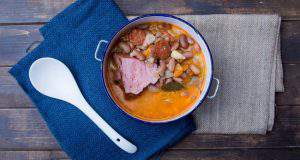Recipe of the week: Jókai bean soup

Mór Jókai, one of the greatest Hungarian authors, loved to include gastronomy and recipe-like descriptions in his novels. He adored Hungarian flavours just like he adored his wife, who was an amazing cook and who always surprised him with delicacies. His all-time favourite meal was a thick bean soup cooked with trotters.
Mindmegette.hu writes that Róza Laborfalvi, the celebrated actress of the time and Mór Jókai’s wife, amazed her husband with a so called “babcsuszpájz” which she probably developed in their mansion found in Balatonfüred.
The author was a real fan of gastronomy, therefore he frequently incorporated food-related episodes into his novels. One of his most famous novels, The Heartless Man’s Sons, is a compulsory reading in most schools. One of the scenes features the following dialogue:
“Well, Mr Pál, what’s for lunch today?” asks the captain who just arrived home.
“Greek beads (görög olvasó)” answers Mr Pál grittily.
“Sounds good” says the captain. “What’s inside?”
“Angel’s boot.”
“That’s delicious! Have you set the table for me, Mr Pál?”
You might be wondering what Greek beads and angel’s boot are. Greek beads refer to a type of bean, which is as big as the ones found on Greek monks’ beads, while angel’s boot is crispy smoked trotters, which is golden and shaped like the shoes of angels.
The writer mentioned “babcsuszpájz” in several of his novels, but never specified the recipe. All in all, Mór Jókai loved to eat, especially the meals his wife cooked. Róza, who was 12 years older than the author, organised divine feasts in their house and even dazzled her mother-in-law with her talent.

One time Jókai wrote that “the fire of love’s altar might die down, but the seduction of the stove is eternal. Every plate is the declaration of love, or its opposite: a quiet divorce”. Although, their relationship was far from divorce. It is believed that Róza Laborfalvi frequently made the famous bean soup in the mansion found in Balatonfüred. However, she only used beans and trotters contrarily to today’s recipes, which also call for vegetables and dumplings.
As Balázs Draveczky, the excellent gastro historian wrote, the vegetables, sausages and dumplings were added later. So many restaurants and cookbooks, so many variations. We decided to pick Károly Gundel’s recipe from the Little Hungarian Cookbook.
Ingredients:
- 180 grams of dry beans or 300 grams of fresh, podded beans
- a piece of smoked trotters
- 100 grams of carrots
- 80 grams of turnips
- few bay leaves
- one clove of garlic
- 150 grams of green peppers
- 70 grams of tomatoes
- 300 grams of sausages
- 40 grams of fat
- 30 grams of flour
- 30 grams of onions
- 5 grams of paprika
- parsley
- 5 dl of sour cream
- 30 grams of flour
- dumplings

Directions:
Rinse the dry beans well and let it sit in water overnight. You can skip this step if you’re using podded beans. Cook the trotters in 1.5 litre of water until very smooth. The next day, roast the chopped up carrots and turnips on the fat that formed overnight on the surface of the cooking water. Add the beans and its soaking water to the roasted vegetables, and add some of the smoked cooking water (in which you cooked the trotters). Add a few bay leaves, the crushed garlic, the chopped up green peppers and tomatoes, some salt and let it cook until the beans soften.
Meanwhile, cook the sausages and cut them up into circles. Then, add the chopped up onions and the flour to the leftover fat of the sausage to make a thickening mixture. Hint it with paprika and parsley. Add this thickening mixture to the soup, then thicken it further with some sour cream. Add the dumplings and the sausages at last. Before serving, cut up the trotters, put some meat on the bottom of the plate and pour over some soup.
Enjoy!
Featured image: www.mindmegette.hu
Ce: bm
Source: Daily News Hungary





